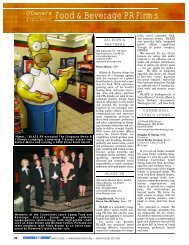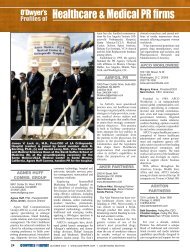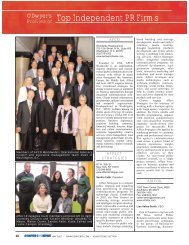Mar. '13 Food & Beverage PR Magazine (PDF) - Odwyerpr.com
Mar. '13 Food & Beverage PR Magazine (PDF) - Odwyerpr.com
Mar. '13 Food & Beverage PR Magazine (PDF) - Odwyerpr.com
You also want an ePaper? Increase the reach of your titles
YUMPU automatically turns print PDFs into web optimized ePapers that Google loves.
REPORT<br />
<strong>Food</strong> headlines focusing on sensationalism, not news<br />
Americans are paying more attention to headlines involving food, according to a recent study by a<br />
top consumer <strong>PR</strong> firm. However, there’s a growing divide between the food stories we’re likely to<br />
remember and those we actually deem important — highlighting a potential preference in today’s<br />
media cycle for junk news over informational substance.<br />
By Jon Gingerich<br />
Compiled annually by New Yorkbased<br />
Hunter <strong>PR</strong>, the food study,<br />
now in its 10th year, polls<br />
Americans to rank the most memorable<br />
food-related headlines that occurred during<br />
the year.<br />
What were 2012’s biggest food stories?<br />
According to the Hunter poll, Chick-fil-<br />
A’s forays into the gay marriage debate,<br />
the controversial use of “pink slime” in<br />
beef products, and the practice of bringing<br />
healthier lunches to our nation’s schools<br />
topped the list, respectfully.<br />
New York City Mayor Michael<br />
Bloomberg’s ban on the restaurant sale of<br />
sodas in containers larger than 16 ounces<br />
took fourth place, followed closely by the<br />
news that McDonald’s would begin posting<br />
caloric information at all U.S. locations.<br />
Michelle Obama’s “Let’s Move”<br />
campaign to fight childhood obesity took<br />
sixth place, followed by the drought that<br />
plagued much of the Midwest during<br />
2012. At eighth place was the ongoing battle<br />
surrounding Genetically Modified<br />
Organisms, which famously appeared in<br />
California state ballots last November. At<br />
the bottom of the list were ongoing studies<br />
in Omega-3 Oils and the prevalence of<br />
food photography in social media.<br />
Big headlines don’t mean big changes<br />
A prescient takeaway can be seen in the<br />
fact that stories involving nutrition<br />
accounted for seven out of the top 10 stories<br />
that ranked this year. Indeed, more<br />
than a third of those polled by the Hunter<br />
study — 32% — said they considered food<br />
and nutrition stories to be more important<br />
than other types of news. An overwhelming<br />
majority of those polled — 86% —<br />
said they view stories on food and nutrition<br />
to be at least “somewhat important.” About<br />
80% of those surveyed said they feel people<br />
need to take responsibility for what we<br />
eat.<br />
This year, Hunter’s annual survey went<br />
beyond simply gauging popular food-related<br />
stories. Hunter teamed up with Digital<br />
Research Incorporated to analyze the relative<br />
importance of these stories, the perceived<br />
impact they’ve had on consumers<br />
and how it affects their shopping and eating<br />
habits.<br />
This expanded portion of the survey<br />
offers its most telling findings. For one,<br />
according to Grace Leong, Managing<br />
Partner of Hunter <strong>PR</strong>, the study now<br />
reveals many food-related headlines actually<br />
do change consumer behaviors.<br />
However, many of these changes have<br />
occurred in ways that were unexpected.<br />
Specifically, the biggest news items in<br />
this year’s Hunter poll weren’t necessarily<br />
stories deemed most important. In fact,<br />
many of the top food stories of the year<br />
had little or no effect in changing consumer<br />
behaviors, and in many cases were more<br />
likely to be deemed unimportant by consumers.<br />
Take the Chick-fil-A story, for example.<br />
Americans decided this was the most popular<br />
food-related story of the year, but it<br />
ranked sixth in terms of importance, and<br />
only 17% of those polled said it impacted<br />
their decision to eat at the restaurant (making<br />
it the second least impacting story,<br />
above only Bloomberg’s soda ban).<br />
Indeed, recent earnings reports released by<br />
Chick-fil-A shows the story did not result<br />
in a deceased sales for the fast-food <strong>com</strong>pany.<br />
New York City’s famed “soda ban” is<br />
another example. It got more press time<br />
than almost any other food related story<br />
last year — <strong>com</strong>ing in at fourth place —<br />
but landed at the very bottom of the list in<br />
terms of perceived importance.<br />
“The big takeaway here is that we have<br />
to reconcile the fact that just because something<br />
is getting lots of press, it’s not necessarily<br />
doing anything to change our behaviors,”<br />
said Leong. “In this age of fast media<br />
and fluffy headlines people might get aflutter<br />
about things and the media really loves<br />
it, but at the end of the day it doesn’t drive<br />
any change at the register.”<br />
Unlike the Chick-fil-A and soda ban stories,<br />
many nutrition-related headlines that<br />
appeared closer to the bottom of the list<br />
were actually deemed far more important,<br />
and according to the survey, and had a far<br />
greater chance of impacting or influencing<br />
consumer behavior. Headlines involving<br />
GMOs ranked all the way down at numbereight<br />
on the list for example, yet were<br />
ranked as the third most important story of<br />
the year.<br />
Moreover, a large portion of those who<br />
followed GMO headlines in 2012 — 35%<br />
— said they now check food labels as a<br />
result of seeing these headlines. Even more<br />
shocking: one of the least popular of the<br />
top ten food headlines of 2012 — Omega-<br />
3 Oils, which ranked ninth on the list —<br />
actually resulted in the highest level of<br />
impact, affecting about half — 46% — of<br />
consumers who knew about the story.<br />
The takeaway? While Chick-fil-A’s<br />
stance on gay marriage or Bloomberg’s<br />
soda saga have proven to make good copy,<br />
far lesser known stories have had a much<br />
greater impact on consumer behavior once<br />
consumers actually knew about them.<br />
“For a long time we’ve talked about<br />
whose responsibility it is to manage nutrition.<br />
Is it the food <strong>com</strong>pany, or is the onus<br />
on the consumer to make choices and build<br />
a diet that’s healthy?” said Leong. “For me,<br />
these stats are saying that many people<br />
believe the onus is on them to make good,<br />
responsible choices.”<br />
The Hunter survey also found that those<br />
who knew about the Midwest drought<br />
story were more likely to engage in higher<br />
rates of <strong>com</strong>parison and value shopping.<br />
While the story was ranked as the seventh<br />
most popular of the year, consumers considered<br />
it to be the single most important<br />
food-related headline of 2012.<br />
“All this just goes to show you, that as<br />
food <strong>PR</strong> people we have to stay ahead of<br />
the headlines, because more than anything,<br />
we really need to know what these headlines<br />
are doing at shelf,” said Leong.<br />
<strong>Food</strong> gets greater social presence<br />
More people are using social media,<br />
both to educate themselves at the grocery<br />
aisle as well as to share information about<br />
the food they’re eating in restaurants.<br />
According to the Hunter survey, 59% of<br />
respondents aware of the rise of food photography<br />
on social media admitted to taking<br />
pictures of food they’ve ordered at<br />
restaurants.<br />
“The fact that everyone has a smart<br />
phone now really puts more emphasis on<br />
what <strong>com</strong>es out of the kitchen,” Leong<br />
said. “The food has to be prepared right, it<br />
has to look right, because now, basically, a<br />
food critic is sitting at every one of your<br />
tables.” £<br />
14<br />
MARCH 2013 4 WWW.ODWYER<strong>PR</strong>.COM

















